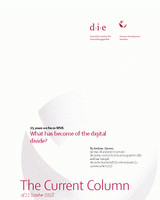15 years on from WSIS
What has become of the digital divide?
Stamm, Andreas / Lea GimpelDie aktuelle Kolumne (2018)
Bonn: German Development Institute / Deutsches Institut für Entwicklungspolitik (DIE), The Current Column of 22 October 2018
Bonn, 22 October 2018. 24 October sees the United Nations celebrate World Development Information Day. Given the growing significance of the information society for global development, this day offers a good opportunity for reflection. It is especially worth considering whether the risk of a digital North-South divide has been averted. The fear of a digital division of the world into one half with and the other half without access to modern information technology dominated international discussion at the turn of the millennium. During this time, it came to be recognised that unequal access to digital infrastructure and technology was closely linked to issues of equality and the fair distribution of opportunities. In 2003, the first phase of the World Summit on the Information Society (WSIS) was held, followed by the second (and final) phase in 2005.
Back then, all indicators pointed to extreme inequality in digital developments between the global North and the global South. In 1998, around 73% of all host computers were still located in North America, and a further 18% in Europe. Just 4% of all internet users lived in Latin America and 1% in sub-Saharan Africa. The risk of the South becoming detached from the global information society was apparent. Consequently, efforts by the international and development-policy communities were primarily directed at improving access to infrastructure and IT services. This was achieved, for instance, by setting up multimedia telecentres, which also enabled poorer sectors of the population to use e-mail and internet services.
Did we overcome the digital divide?
The proportion of internet users worldwide increased from just over 6% to 43% between 2000 and 2015. To this day, however, there are still significant differences between urban and rural areas and between men and women, depending on the development status of the country in question. In 2016, the proportion of the population using the internet was around 81% in developed countries, 40% in developing countries and just 11% in the Least Developed Countries (LDCs). Individuals in rural areas are far less likely to have internet access than those in urban areas. Men use the internet more frequently than women.
One of the targets of Sustainable Development Goal (SDG) 9 is to facilitate universal and affordable access to the internet in Least Developed Countries by 2020. This is an ambitious undertaking and can only be achieved through strategic public-private partnerships. There are numerous observable initiatives by major private enterprises in this area. While not all of them can be assumed to be oriented solely to the global common good, the expertise and investment clout of private firms are indispensable when it comes to further closing the digital divide.
European aircraft manufacturer Airbus recently signed a development partnership with the German Federal Ministry for Economic Cooperation and Development (BMZ) as part of the “Make-IT Alliance”. The partnership is designed to assist local start-ups using aviation and satellite technology to develop new solutions for accessing the internet in remote regions. Through the “Express Wi-Fi” initiative, Facebook is supporting local firms with establishing Wi-Fi hotspots to improve internet access. However, in order to avoid reinforcing the dependence of the South on technology firms in the North, it is also necessary to support local approaches. The “Gram Marg” project in India is a good example in this regard. It is seeking to use idle TV frequencies to provide 5G internet access in rural locations.
Looking back at WSIS, it can be seen that the discussion on the future of the internet has gone from being a technical debate with a number of political implications when it began in 2003 to a highly politicised debate with a number of technical aspects in 2018. And internet access in the sense of infrastructure, costs, skills and local content is just one challenge among several others. There are also questions of international law on the internet, cyber security, digital trade, data ownership and the protection of privacy. Developing countries and emerging economies face the challenge of investing equally in the underlying technology, digital education and related policy-making.
This article reflects the personal opinion of the authors.

